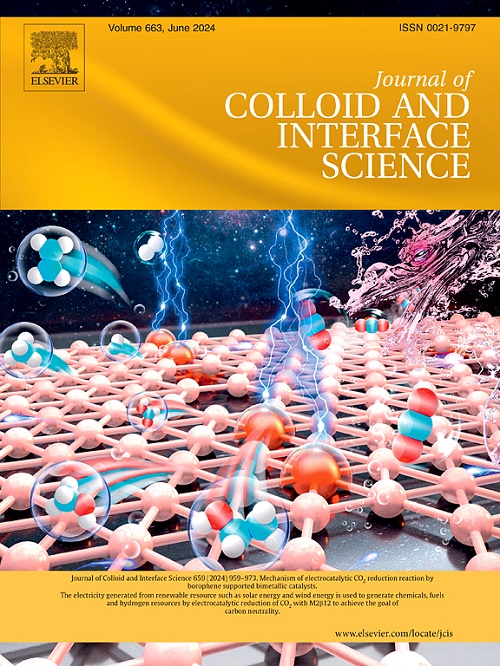将钌单原子锚定在碳纳米管负载的镍基硫化物中以增强电催化析氧
IF 9.7
1区 化学
Q1 CHEMISTRY, PHYSICAL
引用次数: 0
摘要
单原子工程锚定纳米粒子具有最大的原子利用效率和可调配位特性,在水裂解和能量储存方面具有广阔的应用前景。本文采用经济的方法制备了钌(Ru)单原子包埋在碳纳米管(CNTs)负载的亚硫化镍-硫化镍(Ni3S2-NiS)纳米颗粒中,并将其作为析氧反应(OER)的化学催化剂。Ru@Ni3S2-NiS/CNTs的独特结构提供了大量的表面积暴露,促进了电子传递并揭示了许多活性位点。特别是Ru@Ni3S2-NiS/CNTs具有显著的OER催化能力,在碱性电解质中,过电位在10 mA cm−2下降低了221 mV, Tafel斜率降低了74.1 mV dec−1,超过了市售Ir/C催化剂。发现了原子分散的Ru位,Ru单原子被限制在Ni3S2-NiS晶格内,诱导Ru- s - ni成键,作为催化中心,提高了OER的固有活性。此外,Ni3S2-NiS的电子特性被钌原子的掺杂调制。密度泛函理论(DFT)计算表明,原子分散的Ru在Ni3S2-NiS中的存在增强了化学吸附和OER催化活性。该研究拓宽了单原子催化剂领域的重要见解,并为设计可持续能源应用的先进材料提供了有价值的视角。本文章由计算机程序翻译,如有差异,请以英文原文为准。

Anchoring ruthenium single atoms into the carbon nanotubes-supported nickel-based sulfides for enhanced electrocatalytic oxygen evolution
Engineering single atoms anchored on nanoparticles with maximal atom utilization efficiency and tunable coordination character holds a great promise for applications in water splitting and energy storage. Herein, Ruthenium (Ru) single atoms embedded in nickel subsulfide‑nickel sulfide (Ni3S2-NiS) nanoparticles supported on carbon nanotubes (CNTs) are fabricated via economical approach and utilized as chemical catalysts towards oxygen evolution reaction (OER). The unique architecture of Ru@Ni3S2-NiS/CNTs provides substantial surface area exposure, facilitating electron transport and revealing numerous active sites. In particular, Ru@Ni3S2-NiS/CNTs demonstrates remarkable OER catalytic capability, with a reduced overpotential of 221 mV at 10 mA cm−2 and decreased Tafel slope of 74.1 mV dec−1 in alkaline electrolyte, outstripping commercially available Ir/C catalyst. The atomically dispersed Ru sites were identified and the Ru single atoms confined within the Ni3S2-NiS lattice of it to induce Ru-S-Ni bonding, serving as catalytic centers to elevate the inherent activity towards OER. Furthermore, the electronic characteristic of Ni3S2-NiS was modulated with the doping of isolated Ru atoms. Density functional theory (DFT) calculations have illustrated the presence of atomically dispersed Ru into Ni3S2-NiS strengthens both chemical adsorption and OER catalytic activities. This study broadens significant insights into the field of single-atom catalysts and offers valuable perspectives for designing advanced materials in sustainable energy applications.
求助全文
通过发布文献求助,成功后即可免费获取论文全文。
去求助
来源期刊
CiteScore
16.10
自引率
7.10%
发文量
2568
审稿时长
2 months
期刊介绍:
The Journal of Colloid and Interface Science publishes original research findings on the fundamental principles of colloid and interface science, as well as innovative applications in various fields. The criteria for publication include impact, quality, novelty, and originality.
Emphasis:
The journal emphasizes fundamental scientific innovation within the following categories:
A.Colloidal Materials and Nanomaterials
B.Soft Colloidal and Self-Assembly Systems
C.Adsorption, Catalysis, and Electrochemistry
D.Interfacial Processes, Capillarity, and Wetting
E.Biomaterials and Nanomedicine
F.Energy Conversion and Storage, and Environmental Technologies

 求助内容:
求助内容: 应助结果提醒方式:
应助结果提醒方式:


